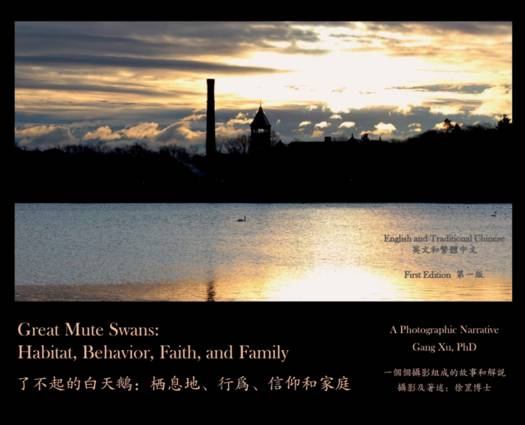
- Afhalen na 1 uur in een winkel met voorraad
- Gratis thuislevering in België vanaf € 30
- Ruim aanbod met 7 miljoen producten
- Afhalen na 1 uur in een winkel met voorraad
- Gratis thuislevering in België vanaf € 30
- Ruim aanbod met 7 miljoen producten
Great Mute Swans
Habitat, Behavior, Faith, and Family--A Photographic Narrative
Gang XuOmschrijving
How did the Chinese character Xi, also a prominent family name in China, originate? The mute swan might very well hold the answer to the question. In 2014, the author, a former Harvard fellow, was stunned to come across a scene in which two mute swan parents disciplined and trained one of their three children, which precisely captured the original meaning of the character Xi. His curiosity about the bird as an intelligent animal species was finally given an opportunity to flourish five years later, when more than two dozen mute swans wintered in the Chestnut Hill Reservoir in the west periphery of the city of Boston, Massachusetts. He soon discovered that mute swans have evolved a practice that can only be characterized as a religion or faith, indicating that religion or faith is not an experience unique to humans. His observations suggest that the bird has formed a primitive civilization with significant social structure.
This book is the fruition of his passionate inquiries and painstaking documentation over a full, intensive year. The most comprehensive book about the mute swan so far, it systemically presents various aspects of mute swans, from their habitat and other birds that share the same water with them, to their relationship with humans, to their behavior, their faith, and their family lives. It integrates photography, nature, sciences, and humanity, as well as tales of his encounters with mute swans and other birds: at one end of the spectrum, the book goes into great detail about mute swans' wing structure; at the other, it brings in early Chinese civilization--Chinese idioms, mythology, Taoism, and the oracle bone script--as relevant to birds.
Among the book's most valuable features:
- 167 sets of beautiful photo illustrations
- A diligent case study on human, environment, and animals
- Careful photo annotations that promote critical thinking and discussion
- Brainstorm questions that encourage open-minded curiosity
- Bilingual in English and Chinese; the two languages are printed side by side to be beneficial to language learners
- A complementary video series on YouTube, titled Dr. Gang Xu's Swan World
A book of stunning discoveries, Great Mute Swans is for a broad audience. With its numerous photographic illustrations, the book is a great gift for families and children of a wide range of ages.
Specificaties
Betrokkenen
- Auteur(s):
- Uitgeverij:
Inhoud
- Aantal bladzijden:
- 268
- Taal:
- Engels
Eigenschappen
- Productcode (EAN):
- 9781736519301
- Verschijningsdatum:
- 5/02/2021
- Uitvoering:
- Hardcover
- Formaat:
- Genaaid
- Afmetingen:
- 279 mm x 216 mm
- Gewicht:
- 1147 g

Alleen bij Standaard Boekhandel
Beoordelingen
We publiceren alleen reviews die voldoen aan de voorwaarden voor reviews. Bekijk onze voorwaarden voor reviews.











